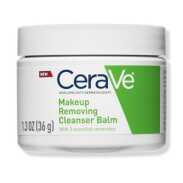Comparison between CeraVe Cleansing Balm vs. Versed Day Dissolve Cleansing Balm
Find out which product is better for your skin.
Ingredients in both products 3
Components only in CeraVe Cleansing Balm 19
Polyethylene, PEG-20 Glyceryl Triisostearate, Water, Ceramide NP, Ceramide Ap and 14 more. Show all.
Uniqueness: 86.4%
Components only in Versed Day Dissolve Cleansing Balm 14
Caprylic/Capric Triglyceride, Coco-Caprylate/Caprate, Polyglyceryl-6 Dicaprate, Synthetic Wax, Tocopheryl Acetate and 9 more. Show all.
Uniqueness: 82.4%
Face to Face
Components position by position
1
Ethylhexyl Palmitate
1
Ethylhexyl Palmitate
2
Polyethylene
2
Caprylic/Capric Triglyceride
3
PEG-20 Glyceryl Triisostearate
3
Coco-Caprylate/Caprate
4
Water
4
Polyglyceryl-6 Dicaprate
5
Ceramide NP
5
Synthetic Wax
6
Ceramide Ap
6
Tocopheryl Acetate
7
Ceramide EOP
7
Caprylyl Glycol
8
Carbomer
8
Eucalyptus Globulus
Show others
Positive Effects
Find out what good effects the product has
Both products provide the following effects: Antioxidant, UV Protection, Moisturizing, Softening, Soothing, Anti-aging, Nutrifying, Antiseptic, Deodorant, Regeneration, Protection, Hair conditioning
Effects unique for Cleansing Balm:
Cleansing, Acne fightingEffects unique for Day Dissolve Cleansing Balm:
Lifting, Elasticity improvement, Rejuvenation, Tones up skin, Anti dandruff, Hair strengthening, Hair structure improvement, Hair gloss, Hair growth stimulating, Hair follicle nutrition-- Show more --
ECO Metrics
Find out how eco-friendly the components are
Vegan
No
No
Cruelty free
No
Yes
Reef safe
Yes
Yes
Ozone layer safe
Yes
Yes
Organic score
natural
4 out of 22
18%
chemical
14 out of 22
64%
natural
12 out of 17
71%
chemical
3 out of 17
18%
Concerns
Pay attention to this information
-- Extra information --
Components by Skin Type
Find out what components are good or bad for your skin type
Dry skin
Positive: 1Negative: 0
Tocopherol#14
Oily skin
Positive: 0Negative: 1
Ethylhexyl Palmitate#1
Sensitive skin
Positive: 0Negative: 1
Benzoic Acid#19
Dry skin
Positive: 3Negative: 0
Persea Gratissima (Avocado) Oil#11Simmondsia Chinensis (Jojoba) Seed Oil#13Tocopherol#15
Oily skin
Positive: 0Negative: 3
Ethylhexyl Palmitate#1Sesamum Indicum (Sesame) Seed Oil#9Persea Gratissima (Avocado) Oil#11
Sensitive skin
Positive: 1Negative: 2
Prunus Armeniaca (Apricot) Kernel Oil#10Eucalyptus Globulus#8Limonene#17

